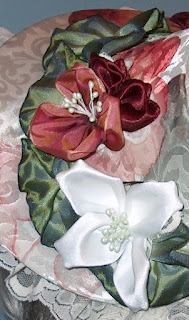Historical Sew Monthly 2019 - July - Unexpected
Make an item with an unexpected feature. Will it be a snazzy lining,
a hidden pocket, or something else? Surprise us!
The Dreamstress
Who doesn't love a surprise! And I certainly got one with the Wearing History AC107 pattern for an Early 1920s Hat. I've made dozens of hats and the basic buckram formula is usually similar: crown tip, crown, and brim. What I didn't realize until I printed the pdf pattern for this hat was that the Standing Crown is actually a separate piece. Genius! The pattern is a revival of an original pattern with both original instructions and additional notes included.
The crown is built from 4 separate wedges creating the stylish tip. That construction technique was unexpected for me as I'm used to one-piece crown tips. Always something new to learn! I wired the edge of the assembled crown, the lower edge of the crown side, and the outside edge of the brim for structure. I used a very light buckram readily available in most chain fabric stores.
The unexpected feature of this hat is the separate standing crown. I wired the top and bottom edges for structure and covered the outside with a fabric matching my 1920s jacket. I lined the standing crown with the same simple black cotton used on the rest of the hat. Imagine being able to use the same hat base and changing the separate standing crown for separate outfits. Perfect for travelling in style!
An unexpected trim feature on the underbrim. Only seen by someone standing very close. ;)
Historical Sew Monthly
What the item is: Hat
What is the unexpected feature: Removable and interchangeable standing crown.
Material: Buckram, cotton, silk crepe du chine, flannel for mulling
Pattern: Wearing History AC107 Early 1920s Hat Pattern
Year: Early 1920s
Notions: Millinery wire, French elastic
How historically accurate is it? Created from a pattern made from vintage instructions and hand sewn in accurate techniques
Hours to complete: 8 hours
First worn: Miss Phryne Fisher day at Costume College 2019
Total cost: $55
.jpg)













































